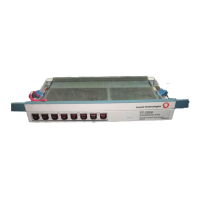Operations Interfaces
Issue 8.0 July 2002
6-19
n A flashing FAULT LED on the System Memory circuit pack shows that the
contents of the nonvolatile memory differ from the duplicate copy in the
System Controller circuit pack. It can also indicate corrupted data in the
nonvolatile memory of the System Memory circuit pack.
Office Alarms Interface 6
The FT-2000 OC-48 Lightwave System provides relays for connection to the local
office audible and visible alarms. Relays are provided for each alarm condition:
CR (critical), MJ (major), and MN (minor). The steady state current for office
alarm connections must not exceed 0.9 A at 60 V or 1.8 A at 30 V. The maximum
transient currents (20 msec duration) during initial contact closure must not
exceed 9 A at 60 V or 18 A at 30 V.
!
CAUTION:
The office alarms interface of the FT-2000 OC-48 Repeater Bay is optional.
If the office alarms interface of the FT-2000 OC-48 Repeater Bay is used,
there is a certain class of single failures that causes the office alarms
interface to be activated in TWO offices. If this occurs and technicians at
each office react to the alarms, service could be dropped.
The audible office alarms are silenced through activation of the alarm cutoff
(ACO) function. Visible alarms are not extinguished by the ACO function.
To prevent intermittent failures from causing unnecessary maintenance activity, a
provisionable incoming signal alarm delay is provided. The office alarms will not
be activated unless an incoming signal condition of greater duration than the
alarm delay occurs. When a failure clears, an alarm clear delay prevents
premature clearing of the alarm.
To accommodate Bell Operating Company (BOC) practices, the MJ and CR relay
closures are designed to allow these office alarms to be OR'ed together and
reported as an office MJ alarm.
As with the user panel LEDs, when multiple alarm conditions occur, the highest
level office alarm (audible and visible) is activated. When the highest level alarm
condition clears, the office alarm "bumps down" to the next highest level alarm
condition.
If the ACO function has been activated to silence the active audible alarm and a
"bump down" occurs, the audible alarm remains silent (that is, the lower level
visible alarm is activated, but the corresponding audible alarm is not reactivated).
If another alarmable condition occurs while the ACO is active, the highest level
audible alarm is activated even if the new condition is a lower level. (For example,
if an MJ alarm was active and silenced using the ACO function and an MN
alarmable condition occurs, the MJ audible alarm will sound.)

